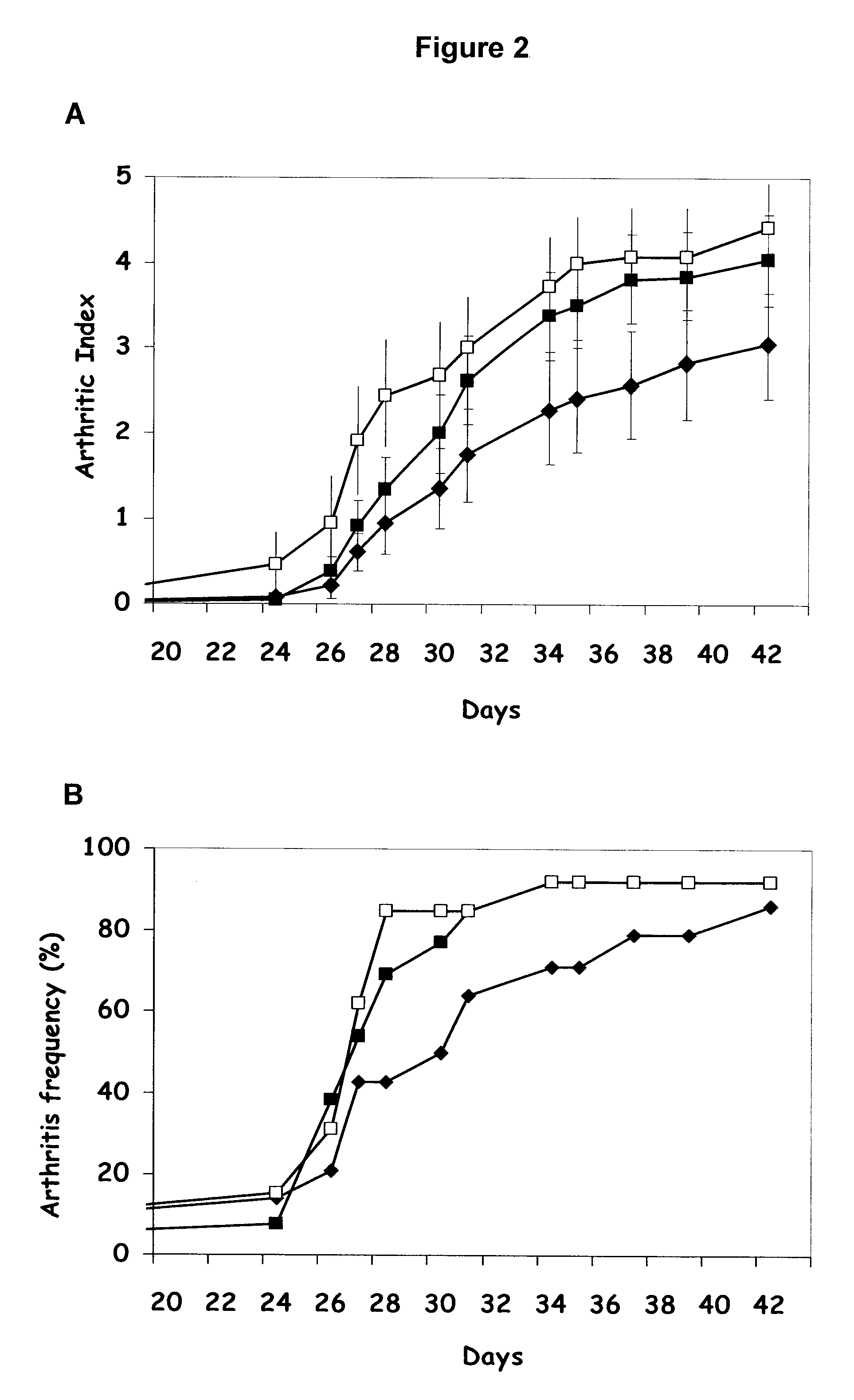New composition and methods for treatment of autoimmune and allergic diseases
a technology for autoimmune and allergic diseases, applied in the field of immunomodulating complexes, can solve the problems of minimal efficacy of immunosuppressive agents in treating ms, drug interactions with significant renal toxicity, empirical and unsatisfactory management of human systemic autoimmune diseases, etc., and achieve the effect of reducing severity and incidence of arthritis, increasing expression and production of fusion proteins
- Summary
- Abstract
- Description
- Claims
- Application Information
AI Technical Summary
Benefits of technology
Problems solved by technology
Method used
Image
Examples
example 1
Immunomodulating Complex K-CTA1-R7K / C187A-COL-DD
[0158]Construction of CTA1-DD mutants, expression and purification of fusion proteins were performed essentially as described by Agren (J Immunol 1999, 162: 2432-2440).
[0159]The pCTA1-DD plasmid contains the cholera toxin A1 gene (aa 1-194) cloned at HindIII-BamHI and DNA coding two D fragments from the staphylococcal protein A gene under the control of the trp promoter. DNA encoding a collagen peptide, the shared immunodominant collagen II peptide (CII260-273), was inserted between DNA encoding the CTA1 and the DD moieties giving the pCTA1-COL-DD plasmid. The R7K and C187A mutations were constructed by in vitro mutagenesis giving the plasmid pK-CTA1-R7K / C187A-COL-DD (FIG. 1).
example 2
Comparison of the Therapeutic Effects of CTA1-R7K-COL-DD and K-CTA1-R7K / C187A-COL-DD in the Mice CIA Model
[0160]The mouse Collagen Induced Arthritis (CIA) model of RA was used to compare intranasal treatments with the CTA1-R7K-COL-DD and K-CTA1-R7K / C187A-COL-DD tolerogen. The CIA model shares a number of clinical, histologic, and immunologic features with RA, and is therefore the most used model to test potential therapeutic agents against RA. DBA1 mice (Taconic, Denmark) were given a primary immunization with 100 μg chicken / bovine collagen type II (Sigma / MDBioSciences) in complete Freund's adjuvant (CFA) followed by a booster with incomplete Freund's adjuvant (IFA) on day 21. The mice were treated intranasally with 3-8 doses of PBS, CTA1-R7K-COL-DD or K-CTA1-R7K / C187A-COL-DD around the time of and / or after the booster immunization. Mice were then followed with regard to the incidence and severity of arthritis using a scoring system for arthritis.
[0161]A clinical scoring system of 0...
example 3
Comparison of the Therapeutic Effects of CTA1-R7K-COL-DD and K-CTA1-R7K / C187A-COL-DD in the Mice CAIA Model
[0164]Collagen Antibody-Induced Arthritis (CAIA) was induced in Balb / c mice (Taconic, Denmark) day 0 by an intravenous injection of a cocktail of monoclonal antibodies to Collagen II (ArthritoMab cocktail: D1, F10, A2 and D8; MD Biosciences, Zurich, Switzerland) at a dose level of 2 mg / mouse. On day 3, lipopolysaccharide (LPS) (ArthritoMab kit, MD Biosciences) was injected intraperitonally to enhance the incidence and severity of the disease (50 μg / mouse).
[0165]The mice were treated intranasally on day −2, 0, +3 with 5 μg K-CTA1-R7K / C187A-COL-DD or CTA1-R7K-COL-DD in 20 μl PBS. The mice were followed with regard to the incidence and severity of arthritis using the same scoring system for arthritis as for CIA (see Example 2).
[0166]On day 4, all mice started to show signs of disease (data not shown). In the PBS control group and in the group treated with CTA1-R7K-COL-DD, the arth...
PUM
| Property | Measurement | Unit |
|---|---|---|
| body weight | aaaaa | aaaaa |
| body weight | aaaaa | aaaaa |
| flow rate | aaaaa | aaaaa |
Abstract
Description
Claims
Application Information
 Login to View More
Login to View More - R&D
- Intellectual Property
- Life Sciences
- Materials
- Tech Scout
- Unparalleled Data Quality
- Higher Quality Content
- 60% Fewer Hallucinations
Browse by: Latest US Patents, China's latest patents, Technical Efficacy Thesaurus, Application Domain, Technology Topic, Popular Technical Reports.
© 2025 PatSnap. All rights reserved.Legal|Privacy policy|Modern Slavery Act Transparency Statement|Sitemap|About US| Contact US: help@patsnap.com



